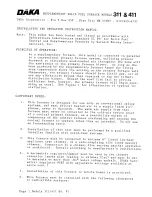
Two- Stage Multi Position Furnace
Service Manual
19
440 08 2002 02
21. ST9162A/SV9541Q TESTING SEQUENCE
If furnace successfully passes this testing sequence, it can be assumed that there are no problems with the ST9162A/SV9541Q CONTROL SYS-
TEM. If it does not, however, it doesnot necessarilymean that there areproblems withthe control SYSTEM. Any malfunctionsshould bethoroughly
investigated before replacing any components.
CHECKING
HEATING
FUNCTIONS
1. JUMPER “W
1
, or W
1
& W
2
” TO “R”
2. CHECK COMBUSTION BLOWER START--UP
3. CHECK IGNITION SYSTEM ACTIVATION
4. WHEN MAIN BURNER LIGHTS, CHECK
HEATING FAN “ON” DELAY
5. CHECK HEATING SPEED FAN OPERATION
6. REMOVE JUMPER
7. CHECK POST PURGE DELAY
8. CHECK HEATING FAN “OFF” DELAY
CHECKING
COOLING
FUNCTIONS
1. JUMPER “Y” & “G” TO “R”
2. CHECK COOLING FAN DELAY “ON”
3. CHECK COOLING SPEED FAN OPERATION
4. REMOVE JUMPER
5. CHECK COOLING FAN “OFF” DELAY
22. HONEYWELL SV9541Q 2- STAGE GAS VALVE/IGNITION CONTROL
Figure 30
Honeywell ST9541Q Ignition System
Gas Valve/Ignition Control
Ignition/Sensor
Pilot Burner/Sensor
INLET
OUTLET
Manifold Pressure
Adjustment
LO
HI
The system consists basically of only two (2) components.
The Ignition System Control and the Pilot Hardware. They
operate on Two (2) power circuits received from the
ST9162A Fan Timer/Furnace Control. One is the 24 volt
power supply for the ignitor, and to activate the ignition se-
quence. The second is a 115 volt circuit used to power the
combustion blower.
The SV9541Q system
is not polarity sensitive.
The SV9541Q Ignition System Control(working in conjunc-
tion with the ST9162A fan timer) manages the Ignition Se-
quence, and the flow of gas to the pilot and main burners.
It is in essence a combination Gas Valve and Ignition con-
trol.
It contains sophisticated electronic components (internally)
and has NO USER SERVICEABLE COMPONENTS.
Should a problem be verified internally within the device,
IT IS NOT FIELD REPAIRABLE, and must be replaced.
The Pilot Hardware includes the pilot burner, the hot sur-
face element that lights the pilot burner, the flame rod that
senses pilot flame, and the cable that attaches to the sys-
tem control.
The hot surface element is made of a tough
break resistant
ceramic composite material. It operates on 24 Volts A.C.
The Igniter/Flame Rod assembly can be replaced indepen-
dently from the pilot burner assembly.
The hot surface igniter can be checked for resistance. A
“Good” igniter will have a resistance of 10 Ohms or less.
Flame current for this system should be 2.0 microamps or
higher. Carrier voltage for flame signal (i.e. flame rod to
valve body) is 80 volts or higher.















































